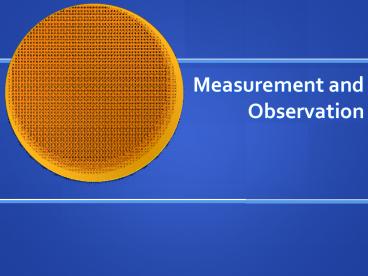Measurement and Observation - PowerPoint PPT Presentation
1 / 32
Title:
Measurement and Observation
Description:
Creating operational measures forces realization about lack of ... Dichotomy: Democrat or Republican. Continuum: 7-point scale w/ 'independent-leaner' ... – PowerPoint PPT presentation
Number of Views:59
Avg rating:3.0/5.0
Title: Measurement and Observation
1
Measurement and Observation
2
Choices During Operationalization
- Researchers make a number of key decisions when
deciding how to measure a concept - Dimensions and sub-dimensions
- Range of variation within dimensions
- Categories to represent range
- Levels of measurement
- Nominal, ordinal, interval, ratio
3
Operationalization A deliberative process
- Not a simple, linear process
- Complicated and fraught with trade-offs
- Iterative process with cycles of consideration
- Debate over proper measurement is key
4
Dimensions of the Concept
- Creating operational measures forces realization
about lack of conceptual clarity - List of possible dimensions may be long
- Need to decide which ones are most relevant
- Ask which ones are central to the inquiry
- Reflect on research hypotheses or theories
5
Range of Variation
- Sense of the upper and lower limits
- How much are you willing to combine different
people into the same category? - Extremely high and Extremely low may be collapsed
- Eg. Income, age, height, etc.
- Opposition and support for attitudes
- Agreement and disagreement
6
Variation Between Extremes
- Degree of precision
- How detailed you need to be in measurement
- Eg. Age breaks or Exact age?
- Related to purpose of study
- Eg. Political Party ID
- Dichotomy Democrat or Republican
- Continuum 7-point scale w/ independent-leaner
7
Levels of Measurement
- Nominal Measures
- Ordinal Measures
- Interval Measures
- Ratio Measures
8
Nominal Measures
- Names for characteristics
- Do not Exist along an Explicit continuum
- Exhaustive
- Mutually Exclusive
- Eg. Religious Affiliation
- Eg. Place of Birth
9
Ordinal Measures
- Can be logically rank-ordered
- Represent relatively more of less of variable
- No consistent distance between points of
measurement - Not just different from one another
- More of less of some attribute
- Eg. Not very important, fairly important,
very important Extremely important
10
Interval Measures
- Consistent distance separating attribute
- We can say how much more of an attribute
- Logical distance between attributes can be
Expressed in meaningful standard intervals - Eg. Temperature
- 90 degrees vs. 80 degrees 10 degree difference
- 50 degrees vs. 40 degrees 10 degree difference
- Zero-point is arbitrary
11
Ratio Measures
- In addition to all the properties of nominal,
ordinal, and interval measures, ratio measures
have a true zero point - Eg. Length of time
- Eg. Number of times
- Eg. Number of affiliations
- Can actually state ratio of one to another
- X has twice as many affiliations as Y
12
Whats that scale?
- Style of music in a music video
- Number of violent acts in a music video
- Whether a music video has violence or not?
- High, Medium or Low violence in a music video
- Hair color
- Number of hairs on your head
- Sat scores
- Social Security Number
13
Whats that scale?
- A baseball player's batting average
- A baseball player's field position
- A baseball player's position in the batting
order - A baseball player's uniform number
- College football rankings
- IQ
14
Types of questions
- Multiple choice questions
- Agree/disagree questions
- Likert questions
- Frequency scales
- Semantic differential scales
- Forced-choice statement pairs
- Thermometer feeling scales
- Nominal checklists
- Ordinal categories
- Rank-order questions
- Filter questions
- Open-ended
15
Multiple Choice Question
16
Multiple Choice with Range Options
17
Agree/Disagree Questions
18
Likert Scale
19
Frequency Scale
20
Semantic Differential Scales
21
Forced-choice Statement Pairs
22
Thermometer Feeling Scales
23
Nominal Checklist
24
Ordinal Categories
25
Rank-order Preference Questions
26
Rank-order Evaluation Questions
27
Filter Questions
28
Open-ended Questions
29
Tips on Question Construction
- 1. Make questions clear using simple language
- 2. Keep questions concise
- 3. Provide instructions for answering questions
- Dont assume respondent knows question style
- 4. Keep research purpose in mind
- Make sure items can answer research question
- 5. Dont ask double-barreled questions
- E.g., How well do you think the current
Presidential Administration is handling foreign
policy and the war on terrorism?
30
More Tips
- 6. Avoid leading questions
- E.g., Like most Americans, do you read a
newspaper every day? - 7. Avoid negative questions
- E.g., The U.S. should not invade Iraq Agree or
disagree? - 8. Do not ask questions that require complicated
mental calculus - E.g., In the past 30 days, how many hours have
you spent watching television with your family? - 9. Keep ordering of questions in mind
31
Using Pre-Existing Measures
- It is okay to borrow measures
- Cite source of questions to give credit
- Benefits of using Existing measures
- Saves work
- Pre-tested for reliability/validity
- Research becomes cumulative
32
Pretesting
- Clarity in question wording
- Are categories
- Exhaustive?
- Mutually Exclusive?
- Realistic time estimate
- Preliminary empirical analysis































